Potential use cases of AI
For trade finance professionals
Presented as an introduction into this chapter is excerpt from a 2023 Interview between Dwarkesh Patel and Ilya Sutskever. Ilya Sutskever is the cofounder and former chief scientist of OpenAI, and was a lead contributor in the creation of ChatGPT.
Dwarkesh:
Let's say it's 2030 and not that much economic value has been created by these LLMs. As unlikely as you think this might be, what would be your best explanation right now of why something like this might happen?
Ilya:
I really don't think that's a likely possibility, that’s the preface to the comment. But if I were to take the premise of your question, why were things disappointing in terms of real-world impact? My answer would be - reliability. If it somehow ends up being the case that you really want them [LLMs] to be reliable and they ended up not being reliable, or if reliability turned out to be harder than we expected. I really don't think that will be the case. But if I had to pick one and you were telling me — hey, why didn't things work out? It would be reliability. That you still have to look over the answers and double-check everything. That just really puts a damper on the economic value that can be produced by those systems.
Dwarkesh:
Got it. They [LLMs] will be technologically mature, it’s just the question of whether they'll be reliable enough.
Ilya:
Well, in some sense, not reliable means not technologically mature.
Large Language Models (LLMs) / AI chatbots
The present offers of AI chatbots provide added value to trade finance and insurance industries, specifically in contributing added value to workflows of trade finance professionals. There is a broad range of offers on the selling side of LLMs / AI chatbots to both consumers and corporate clients – e.g. ChatGPT, Claude, Llama, Perplexity etc.
A McKinsey study from 2015 found that 45% of employee time could be automated with then existing technologies. The same study however found that only 5% of employee time could be fully automated – meaning no input and output-checking by humans is required. The sophistication of technology for automation has increased in scope and scale since 2015, and current AI chatbots are great at helping design automation solutions for the 45% parts, yet not so much the 5% - at least not yet, as AI output validity is not reliable. Current market tendency is to not base critical processes on AI outputs.
ChatGPT for example, offers a disclaimer below their input box: “ChatGPT can make mistakes. Check important info”. Claude from Anthropic presents a different version: “Claude can make mistakes. Please double-check responses.”
Some of the benefits of AI chatbots include:
Distillation of knowledge from the web
AI chatbots are trained on vast amounts of text-based data on the internet - including Wikipedia, answers from search results, various papers, case studies, and world literature. State-of-the-art AI systems posess a large knowledge base about trade finance and its instruments.
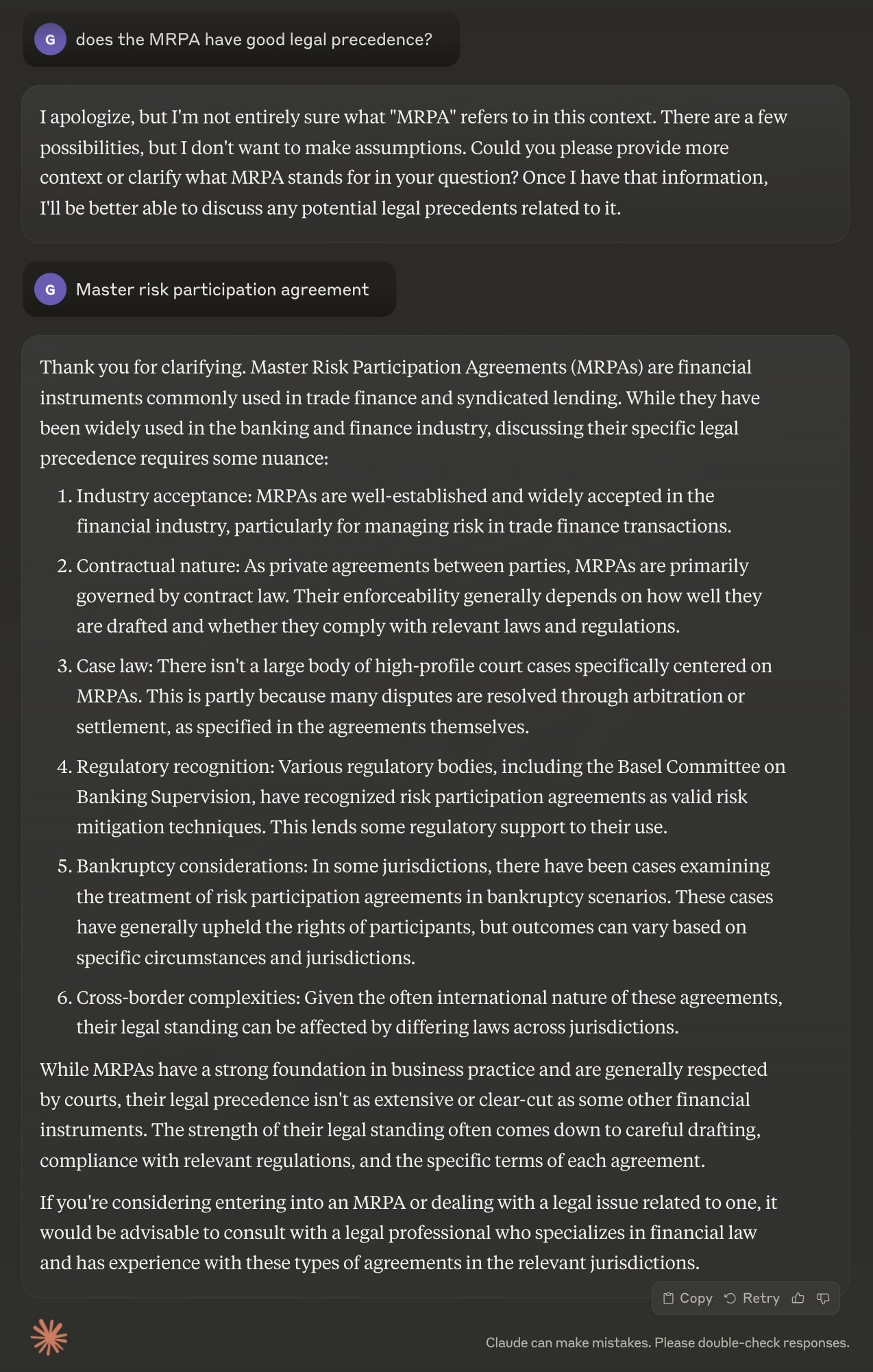
Question answering
Providing answers about a vast array of topics, including answers from user-uploaded proprietary data, e.g. specific trade documents or financing facility information.
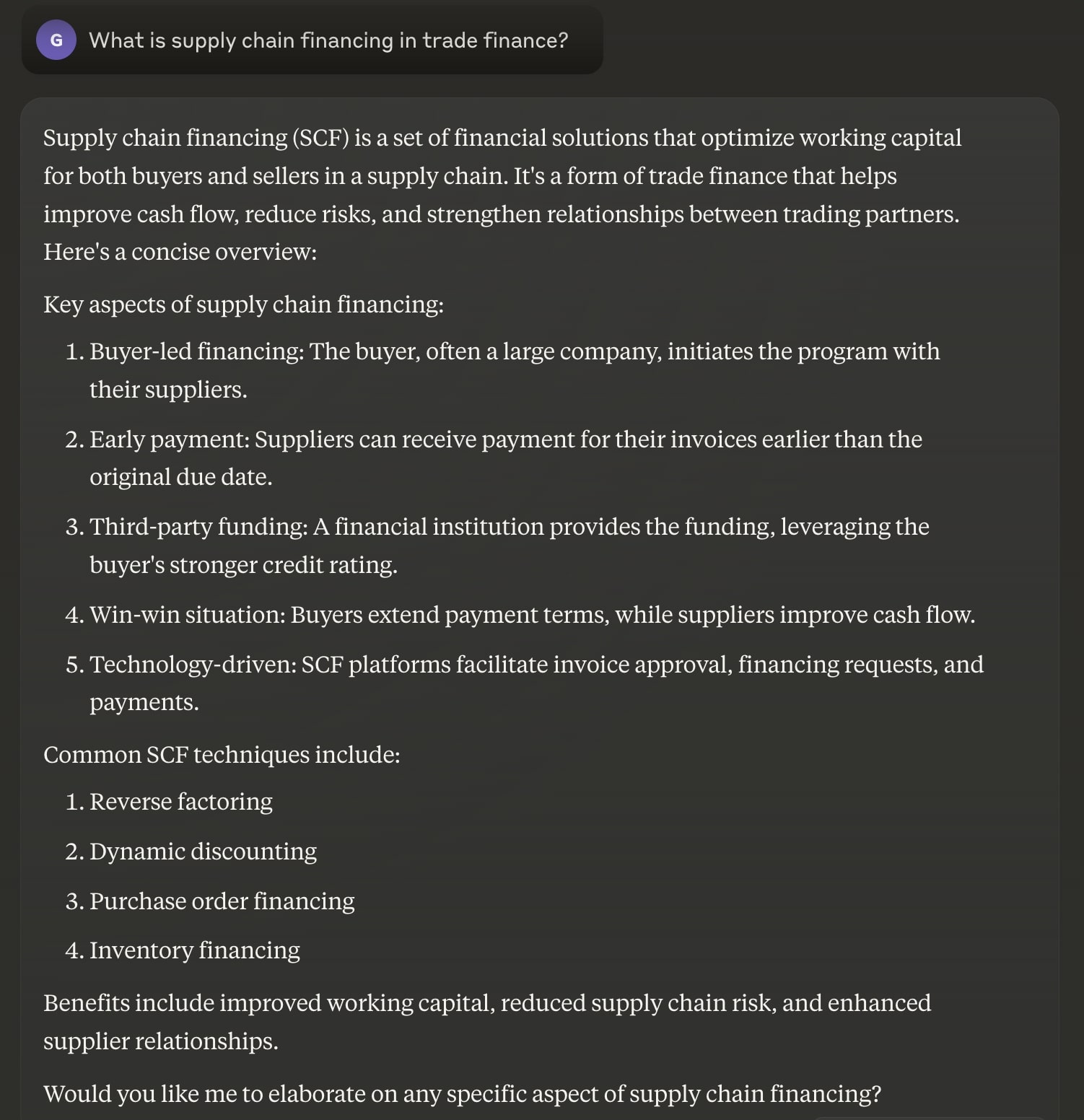
Text summarization and analysis
Condensing large texts and outlining relevant information.
Writing assistance
AI chatbots can help with various forms of writing, from creative to technical. Chatbots excel at recognizing and pointing out spelling and syntax mistakes in writings. With legal writings, such as distribution contracts, AI chatbots could provide real time feedback on deviations from market standards and the potential impact thereof.
Translation
AI chatbots excel in translating between numerous languages with high degree of accuracy, providing output rated higher in human evaluations scores compared to non-AI solutions. AI can also generate natural sounding speech in different languages, enabling real time voice-to-voice translation. E.g. OpenAI has recently announced the voice feature with ChatGPT 4o. This could prove useful in meetings held in a language not spoken fluently by all present parties.
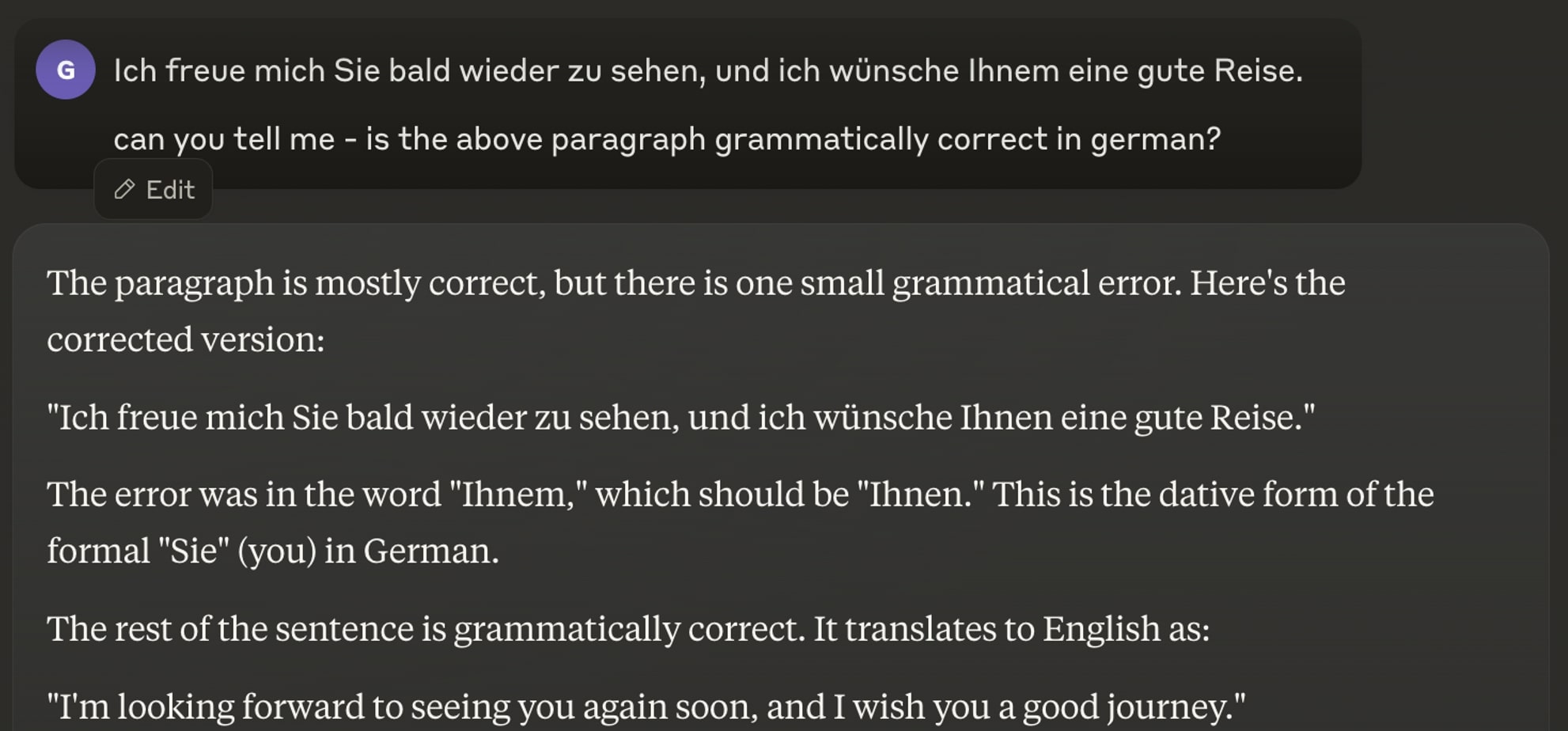
Code generation and debugging
AI chatbots excel at generating code in multiple programming language - e.g. Python. This capability offers tremendous potential for trade finance professionals to automate repetitive tasks.

Program guides
AI chatbots can prove useful guides on how to complete complex tasks on many popular computer programs. They are trained on data relating to use of programs such as Adobe Photoshop, Microsoft’s Office Suite, PowerBI, video editing software, program specific APIs etc.

Task planning and problem-solving
Brainstorming and outlining potential solutions to complex problems, e.g. structuring a financing facility that fits with a particular situation or a particular client.
Data analysis and interpretation
Examining vast datasets and crafting data analysis with visual aids.
Conversational AI
Engaging in coherent, context-aware dialogues.
Content generation
AI chatbots can assist in creating various types of content, such as scripts, images, articles, replies., etc. Useful for creating presentations and client engagement materials.
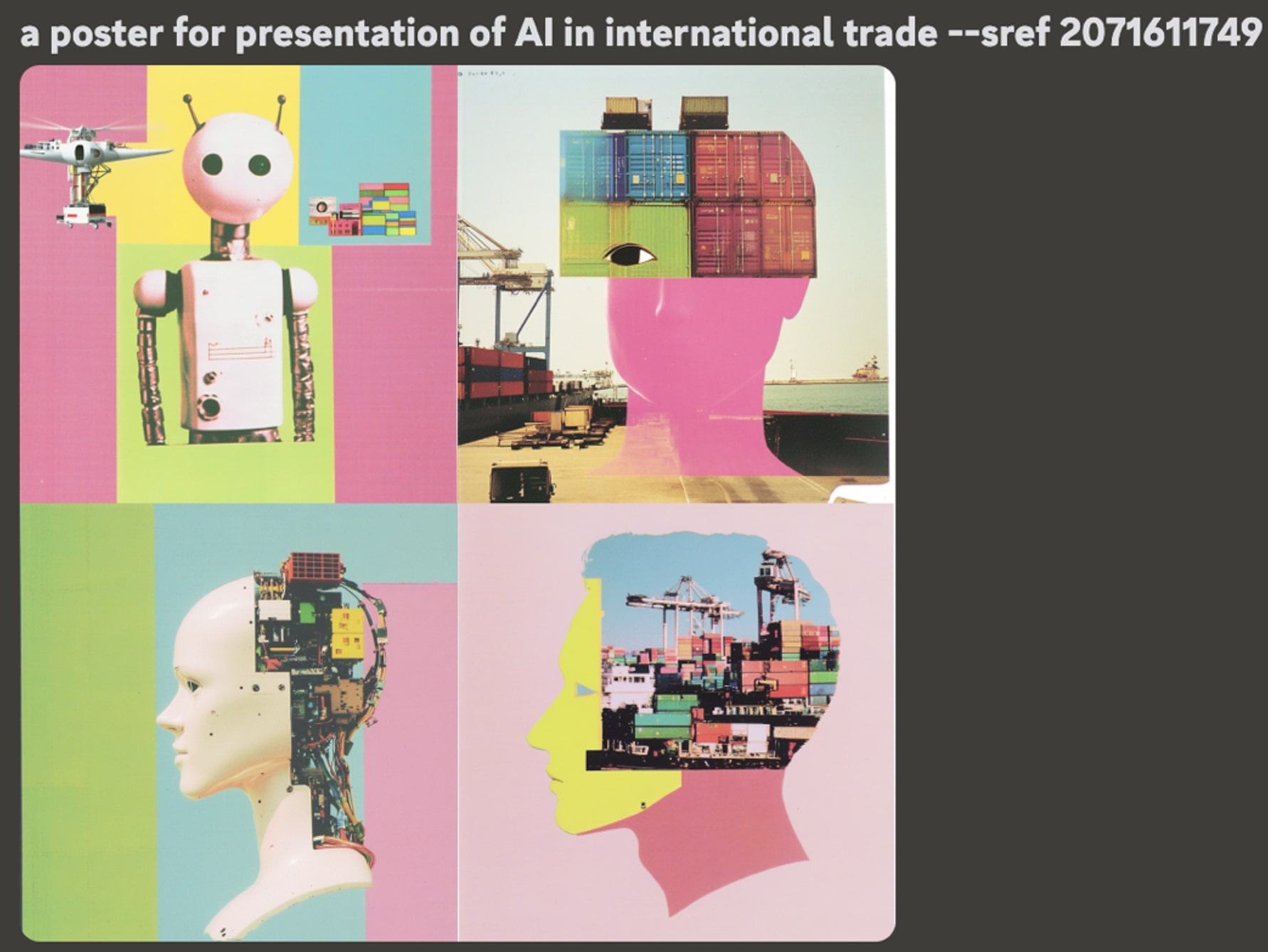
Information retrieval and organization
Quickly accessing and structuring relevant information, specific queries to SQL databases with instructions written in natural language – e.g. relating to a financing facility’s past performance or specific KPIs.
Sentiment analysis
Helping users to determine the emotional tone of text, giving feedback and second opinions on structured replies.
Presentation creation assistance
AI chatbots can be helpful in condensing content to help create presentations, potentially saving time and effort in constructing client engagement materials and other types of slide decks.
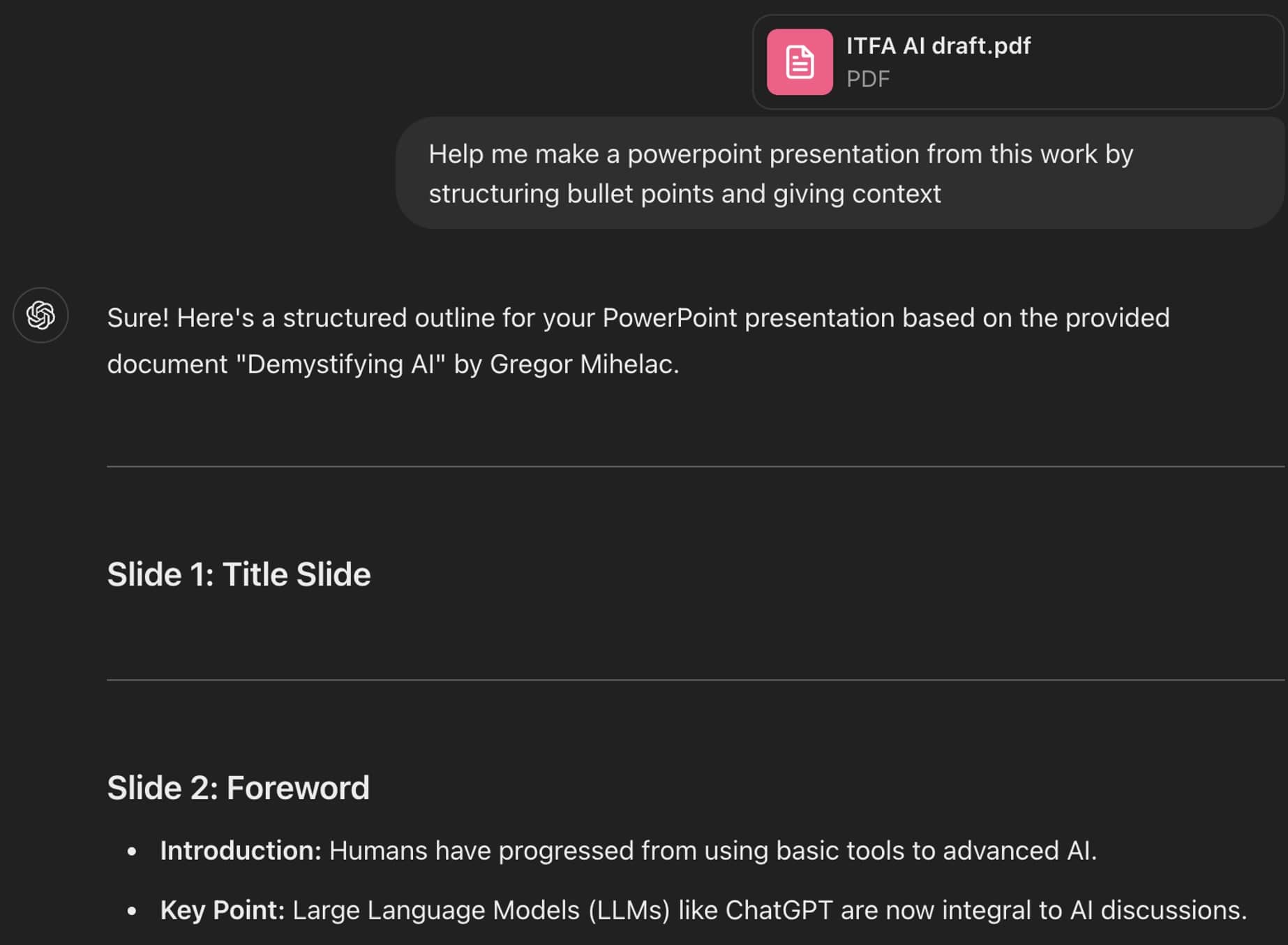
For organizations implementing general-purpose AI chatbots, to market tendency is to implement AI chatbots on a company-wide basis, usually in cooperation with Microsoft, Google, IBM, or another third-party digital services provider. Similarities can be drawn with organizations choosing an email or a videocall solution provider - the decision to go with either Outlook vs Gmail, Zoom vs Teams, Notion vs SharePoint, etc. is going to usually be decided outside of trade finance and specific insurance departments, and be made accessible to multiple divisions of an enterprise simultaneously, with a company-wide code of conduct and licence agreements.
Fraud and plagiarism detection:
Modern AI systems generate natural sounding language, raising concerns about plagiarism and weaponization of bots pretending to be human actors. AI algorithms in turn can identify patterns and anomalies in data to flag potentially fraudulent or AI-generated material.
Imagine a hypothetical scenario: an employee gets a call from their manager, instructing that a client reported the employee’s company used the wrong bank account number to transfer contractual payments, and back office needs to be notified of the mistake immediately. The next payment due today should be to the new, through the call provided bank account number, to avoid the risk of losing a high-value client. The manager is generated by AI, yet the employee is unaware of such.
We are not yet at the point where such a scenario is likely, but this is changing fast. OpenAI has introduced ChatGPT 4o, which comes closest to imitating speech that is not distinguishable as AI generated by humans. With the progress of innovation in this space, AI could in turn be used to counter such risk by flagging communications within a company which are likely to be generated by other AI systems.
Some available soltuions for AI detection:
Content at Scale AI Content Detector: A free tool that analyses text to detect the likelihood that they are AI-generated.
Sapling AI Detector: A browser extension that offers to detect AI-generated content on websites.
HuggingFace AI Detector: An open-source project for detecting AI-generated text.
AI or Not: designed to detect if an image or sound was generated by AI
Illuminarty: designed to detect if an image was generated using AI.
Trade Finance & Insurance specific end-to-end automated AI use cases
Foreword
This section considers non general-chatbot AI solutions for industries relating to International Trade. Currently, the market tendency is to avoid implementing non-human oversight AI solutions to critical end-to-end processes, due to the reliability and liability concerns.
In the realm of autonomous vehicles, both manufacturers and regulatory agencies set high standards for allowing full AI automation. Fully autonomous self-driving vehicles must demonstrate not only an accident and error rate comparable to that of an average human driver - but significantly lower. The same rigorous approach should be applied to the automation of end-to-end trade finance or trade insurance processes with AI solutions, especially those that function as “black box” systems, where the output is not known before it is executed.
Moreover, the regulatory environment for the implementation and the audit procedures thereof are still in their infancy with little to no precedence. The regulatory environment may make some of the below solutions not compliant in certain jurisdictions. All examples below however are already possible with current Transformer-based AI technology.
Document processing
AI could automate processing of documents relating to trade instruments, e.g. letters of credit, bills of lading, invoices etc. An AI system could be implemented to, for example, check whether the conditions set out in a letter of credit have been met by analysing documents submitted by a supplier, and releasing the payment upon a positive confirmation. Even with partially automated approaches, AI solutions could be set up to help trade professionals reach a decision.
Risk assessment
AI systems could analyse a vast sum of historical data to assess the creditworthiness of parties involved in trade transactions, providing an additional mechanism in the credit risk analysis processes.
Compliance monitoring
AI systems could continuously scan transactions and facilities against ever-changing sanctions lists and regulatory requirements, and automatically raise concerns should new regulation mandate changes in workflows or practices.
Smart contracts
AI systems could help create and manage self-executing contracts, with automatic assessment of counterparty risk. Smart contract execution with AI could potentially be combined with blockchain technology, where AI could assess the counterparty risk and blockchain to manage and keep transactions bound by pre-agreed code.
Predictive analytics
AI systems could help forecast market trends, commodity prices, and currency fluctuations based on a large amount of publicly available data to optimize trade finance decisions.
Real-time supply chain visibility
AI systems could provide end-to-end visibility of goods movement in natural language, enhancing risk management and influencing financing decisions.
AI-driven trade finance marketplaces
Platforms could use AI systems to match buyers, sellers, and financiers, running in effect as an optimization algorithm for trade finance solutions based on risk profiles and market conditions at a given time.
Legal guidance and wording
AI systems could help point out potential wording syntax mistakes or point out faulty logic between different sections of a contract. AI systems could automatically adjust a market standard contract template to better fit the transaction, providing a template to work upon that is better suited for a particular transaction and counterparty compared to a market standard template.
Automated claims processing
AI systems could automate some stages of insurance claims processing, including damage assessment from provided images, and help with fraud detection.
Underwriting
AI systems can analyse vast amounts of data and could improve risk assessment and pricing accuracy. Furthermore, AI systems could automate underwriting processes for amounts not large enough to warrant the working hours otherwise required of a human underwriter.
Personalized insurance products
AI systems could analyse individual customer data or past customer failures to offer tailored insurance products and pricing.
Predictive maintenance
For trade credit insurance and supply chain finance related activities, AI systems could predict when maintenance is needed and required by the client, potentially reducing claims.
Real-time risk assessment
AI systems could continuously monitor and adjust risk profiles using internet of things data, allowing for dynamic pricing models.
Automated policy creation
AI systems could draft personalized insurance policies based on individual risk factors and preferences, providing a template better suited for the insured
Proactive risk mitigation
AI systems could predict potential risks based on real time data and suggest preventive measures to insurers and insured.
Autonomous claims settlement
AI systems could handle the small claims process without human intervention for straightforward cases and small amounts.
AI-driven catastrophe response
In the event of disasters, AI systems could quickly assess damage across affected areas using satellite and drone imagery, expediting claims processing and resource allocation, as well as assessing whether the applicable insurance contracts cover the damages. E.g. in deeds of insurance, damage from radiation exposure is often not covered.